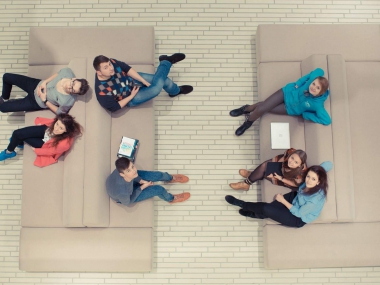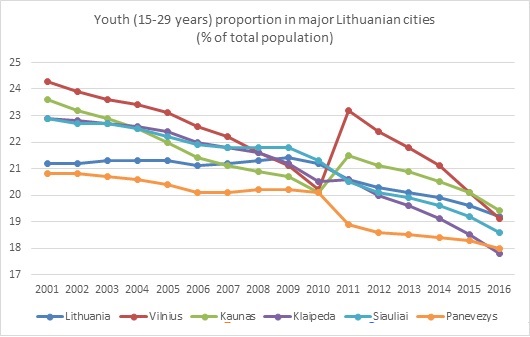GEN-Y CREATIVE-TECH TALENT POLICY ISSUES IN KLAIPEDA
Edited on
12 January 2018Looking at the pattern of general demographic changes across Europe obvious winners are the major cities and regions where the population is stable or increasing and the social fabric is characterized by balance between creators (workers) and dependents. However, the situation differs, especially when comparing capitals and smaller regional centers. Therefore, the emphasis on integrated (holistic) approaches to urban socio-economic development problems is increasing as well as highlight to youth affairs, providing targeted measures.

It is noted that the decline in the number of young people (see Figure 1) can have negative consequences for the country, region or city competitiveness. That is why the solution on current young people’s issues must become an integral part of strategic documents.
Fig. 1 Declining youth in major cities of Lithuania[1]

Although the decreasing number of youth is a significant problem in Klaipeda city (see Figure 2), despite the several efforts to deal with this challenge, it is still recognized that Klaipeda does not have an integrated youth policy strategy and city identity[1] presenting Klaipeda as a youth-friendly city, which attracts young people to study, live and work and created added value to the city and region.
Fig. 2 Changing demographic structure of Klaipeda city

On local level, while the youth affairs are mentored by the city administration which is focused more on implementation of ‘economical’ projects the overall picture of the problem could be lost. Even in the specialized youth-oriented programmes or the implementation of individual actions do not always have a clear and measurable effect. These ‘top-down’ strategies look nice on paper and only partially (fragmentary) are related to the real needs of young people’s needs, that is why the ‘bottom-up’ approach is needed in strategy preparation.
Taking into account the above mentioned trend of declining youth number, Klaipeda city municipality last year (2015) ordered a feasibility study ‘Klaipeda’s youth situation research’. The aim of the research was to determine the young people’s priorities in Klaipeda city and region while choosing place to live, study and work. It was noted that decreasing percentage of working-age people and fading attractiveness of Klaipeda for young people could cause the diminished competitiveness of the city. Despite the fact that in the context of major Lithuanian cities Klaipeda is distinguished as being secure, having friendly community, attractive prices and unique living atmosphere, Vilnius surpasses by the attractiveness of living, opportunities for professional growth and making a career, having purposeful leisure time. The second largest city Kaunas for the possibility to study, get occupation and find a good job. The research identified areas of concern which should get the most attention: lack of preparation for the labour market and low competitiveness of youth in the labour market. The results and conclusions of the research were presented in the discussion with the representatives of businesses, local government, education institutions, youth organizations and other interested parties at the beginning of 2016.
Similar problems and solutions were constantly discussed during 2016 in political level (Council of Youth and Academic Affairs near the Klaipeda City Municipality) as well as in public discussions with youth and NGO’s, in project’s ‘Gen-Y City’ ULG meetings and LAG’s (Local Action Group) strategy creation, etc. Summarizing these discussions and meetings, most of the stakeholders observed and emphasized the lack of youth’s general and professional competences, which correspond to contemporary creative-tech businesses. Klaipeda has a lot of good examples which could be associated with created-tech talent development[1], however practice shows that these innovative, but individual, initiatives do not give the desired results – the vast majority of young people are engaged as amateurs and do not become creative-tech professionals in this field, at the same time lose competitiveness in today’s labour market.
The fundamental problems and challenges of this situation can be distinguished:
§ Lithuania only recently (2013) chose six smart specializations[2], which could have the greatest impact on the country’s economic growth and competitiveness. The strategic goal is to increase influence of R&E (Research and Experimental Work) and innovative solutions for the country’s GDP and structural economic changes.
§ Slow development of STEM (Science, Technology, Engineering and Mathematics) open access centres in Klaipeda. This autumn Klaipeda joined the international project ‘Improving STEM education’, which aims to address the challenges of STEM education in Klaipeda city.
§ Schools of high education in Klaipeda (total 6) are focused on social sciences and do not have good quality creative-tech programmes. Only few of the schools have study programmes directly related to creative-tech field; however the number of students in these programmes compared to Vilnius and Kaunas is very low.
§ Only one school of general education in Klaipeda (Klaipeda’s Lyceum) launched engineering curriculum, which focuses to STEAM education. Such education can encourage students to learn and develop necessary skills in fast changing world.
§ The lack of strategic partnership between non-formal creative-tech educators, general education system, businesses and cultural industries influences young talents: often young amateurs are not encouraged to continue theirs activities at a professional level.
§ The image of the city is not related to the creative-tech field and city does not see the opportunities to position itself in this area.
Mentioned challenges can be attributed to national or local (self-government) level, also non-formal and formal educational institutions. However, in order to attract, retain and develop creative-tech talents it is necessary to have a long-term complex and integrated approach and strategic partnership at all levels.
[1] Open Youth Center, incubator of creative industries ‘Culture Factory’, Klaipeda’s Science and Technology Park, Klaipeda University Business Incubator, ‘Smart School’, Academy of Robotics, etc.
[2] 1) Energy and sustainable environment, 2) inclusive and creative sočiety, 3) agroculture inovations and food technologies, 4) new manufacturing processes, materials and technologies, 5) health and biotechnology, 6) transport, logistics and ICT.
[1] Declaration of open discussion ‘Why the number of young people is declining in Klaipeda, Lithaunia and EU?’ during the annual event ‘Klaipeda – youth port. YOUTH WEEKEND’ (9 September 2016, Klaipeda)
[1] The official population statistics only partly reflects the real situation, because most mobile part of society – young people – during their education and study period remain registered in their parents’ home. Therefore, it is likely that in Vilnius and Kaunas (where major universities and IT companies are concentrated) the actual proportion of young people is significantly higher than in other major cities of the country.
 Submitted by Karolina Prymas on
Submitted by Karolina Prymas on
